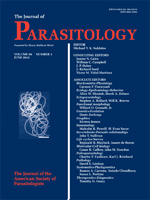Besnoitia besnoiti is an apicomplexan that causes serious economic loss in cattle in many countries and the disease is now spreading in Europe. At least 2 phases of bovine besnoitiosis are recognized clinically. An acute febrile phase characterized by anasarca and necrosis of skin is associated with multiplication of tachyzoites in vascular endothelium; this phase is short-lived and rarely diagnosed. Chronic besnoitiosis characterized by dermal lesions is associated with the presence of macroscopic tissue cysts and is easily diagnosed. Here we report the development of early B. besnoiti tissue cysts in a naturally infected Hugenoot bull from South Africa. Tissue cysts were 10–70 μm in diameter, contained 1–12 bradyzoites, and were most numerous in the dermis, testicles, and pampiniform venous plexus. Amylopectin granules in bradyzoites stained red with periodic acid Schiff (PAS) reaction. Bradyzoites varied in size and in the intensity of PAS reaction (some were PAS-negative), some were plump, and others were slender. With immunohistochemical staining with Besnoitia oryctofelisi and bradyzoite-specific antibodies (BAG-1 made against Toxoplasma gondii bradyzoites), the staining was confined to parasites, and all intracystic organisms were BAG-1 positive. With Gomori's silver stain only bradyzoites were stained very faintly whereas the rest of the tissue cyst was unstained. Ultrastructurally many tissue cysts contained dead bradyzoites and some appeared empty. Unlike bradyzoites from mature cysts, bradyzoites in the present case contained few or no micronemes. These findings are of diagnostic significance. Ultrastructually host cyst cells had features of myofibroblasts, and immunohistochemistry using antibodies against MAC387, lysozyme, vimentin, Von Willebrand factor, and smooth muscle actin confirmed this. Polymerase chain reaction on DNA extracted from lymph node of the bull confirmed B. besnoiti diagnosis. Associated clinical findings, lesions, and histopathology are briefly presented. The bull died of nephrotic syndrome; anasarca in acute besnoitiosis due to protein-losing glomerulopathy is a finding not previously reported in cattle.
How to translate text using browser tools
1 June 2013
Development of Early Tissue Cysts and Associated Pathology of Besnoitia besnoiti in a Naturally Infected Bull (Bos taurus) from South Africa
J. P. Dubey,
E. van Wilpe,
D. J. C. Blignaut,
G. Schares,
J. H. Williams
ACCESS THE FULL ARTICLE

Journal of Parasitology
Vol. 99 • No. 3
June 2013
Vol. 99 • No. 3
June 2013




